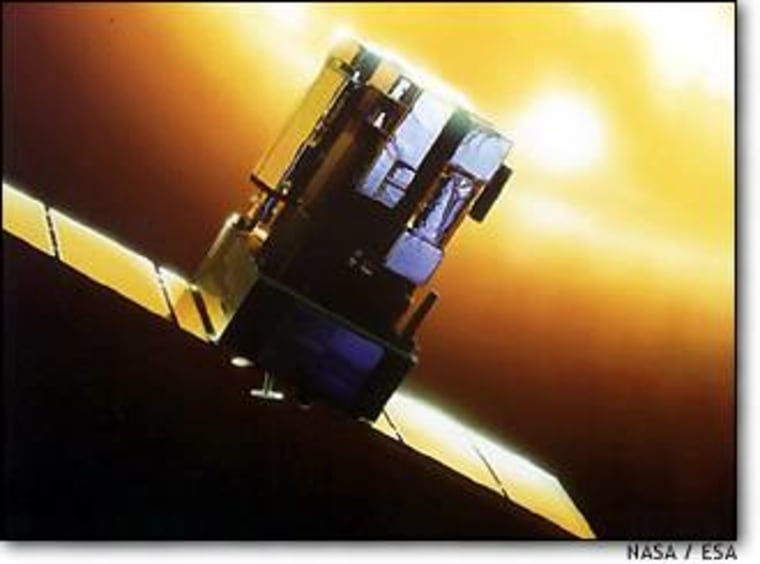If robots had reality shows, SOHO would be the Space Survivor, a craft that surpassed all expectations in the most challenging circumstances. The sun-watching spacecraft has been near death three times and has lasted nearly six years longer than planned. It has revolutionized space weather forecasting and returned countless spectacular photographs of the sun and its violent surface.

EARLIER THIS YEAR, it looked as if SOHO might not survive to its eighth birthday. Thanks to some clever engineering, though, the craft continues to serve as a scientific workhorse.
To mark the upcoming anniversary of the probe’s launch, Space.com and the SOHO science team invite readers to vote for their favorite all-time SOHO images. The Top 10 will be announced on Space.com Nov. 25. (The picks will then be presented on MSNBC.com and other Web sites.)
You can vote now on the SOHO Web site.
A SPACE REVOLUTIONARY
It is not unusual for a spacecraft to transform thinking about the object or phenomena it studies. That’s why billions of dollars are spent every year to build, launch and operate satellites and deep-space probes.
But few robotic craft have matched SOHO’s accomplishments, particularly in providing such a consistent set of observations of a single object over time.
“The imagery has marked out a new path for sensing the sun from space,” Joe Kunches, lead forecaster at NOAA’s Space Environment Center, said in a recent telephone interview. “It gives us in the forecasting business a view of the sun that we never had before.”
Kunches’ organization is not part of the SOHO project, but it relies on the constant downloads from the craft to produce forecasts of impending solar storms, charged particles that can disable unprepared satellites in space as well as power grids on Earth.
“It’s made us all a lot smarter,” Kunches says of SOHO, “the way Babe Ruth made the manager of the Yankees smarter.”
DISCOVERY MACHINE
The Solar and Heliospheric Observatory launched on Dec. 2, 1995. It is a joint project between NASA and the European Space Agency. It was originally slated for a two-year mission, which was extended to 2003 so scientists could observe an expected peak in solar activity during 2001 and 2002. The mission has now been extended to at least 2007.
Kunches points out that the craft’s longevity has now allowed continuous monitoring of a known but poorly understood 11-year solar cycle from its low point, through a peak, and into the decline that is presently under way.
Beyond supporting space weather forecasts, SOHO images have helped scientists understand how the sun works.
SOHO made the first pictures ever of a star’s convection zone, the turbulent outer shell of the sun where local space weather is unleashed. It revealed for the first time the structure of the solar furnace below sunspots, where the problems that become space weather fester.
And along the way the craft has taken very cool photos of comets on death plunges. Serendipitous SOHO images have been used to find more than 600 comets, many making routine trips around the sun and others just days before their final approach.
Earlier this year, armchair astronomers watched in amazement as, live on the SOHO Web site, a comet rounding the sun was apparently blasted by a solar eruption.
ALMOST LOST IN SPACE
SOHO has had its own brushes with death, the most recent event a crippling experience in June. A stuck motor drive would not permit the craft’s primary antenna to move. The antenna is used for transmitting pictures and data back to Earth, and it must be pointed toward the planet. Scientists feared lengthy blackout periods.
Engineers employed some tricks, including flipping the craft upside down during portions of its orbit, to get the data flowing again.
In 1998, changes in the spacecraft’s software inadvertently sent it into a flat spin. The electricity-providing solar panels turned edge-on to the sun, and SOHO lost power. It could not orient itself or maintain its temperature — critical in the frigid environment of space.
The mission appeared doomed.

After nearly three months, with much perseverance by the ground team, contact was re-established, the craft’s orientation was fixed. Sunlight hit the panels, and SOHO was back.
Later in 1998, another problem nearly ended the mission again. The craft’s last navigational gyro failed.
“In a race against time and a depleting maneuvering-fuel supply,” explained SOHO project scientist Bernhard Fleck of the European Space Agency, engineers had to develop a software patch to get the craft back in operation without the gyro. New software was developed in early 1999 to allow a spacecraft to maintain attitude without gyros. Engineers sent it up, “making SOHO the first 3-axis stabilized spacecraft to be operated without any gyros,” Fleck said.
YEARS TO GO
While perhaps not as heralded as some robotic spacecraft — Viking and Galileo come to mind — the SOHO mission’s overall accomplishments were recently recognized by the International Academy of Astronautics.
The IAA gave SOHO the Laurels for Team Achievement Award in recognition of extraordinary performance and achievement by teams of scientists, engineers and managers in astronautics. The award has been issued twice before, to the Russian Mir space station team and the U.S. space shuttle team.
Scientists hope the craft stays healthy until a replacement can be launched in 2008. Kunches, the space weather forecaster, has said no other group of existing satellites can provide the crucial data returned by SOHO alone.
And the mission is certainly cost-effective in its sunset years.
“Considering the enormous investment — about a billion dollars, shared between Europe and the U.S. — to build, test, and launch SOHO, we’re able to operate the spacecraft and its scientific instruments fairly economically, for about $15 million a year,” said U.S. SOHO project scientist Joe Gurman.
© 2003 Space.com. All rights reserved.